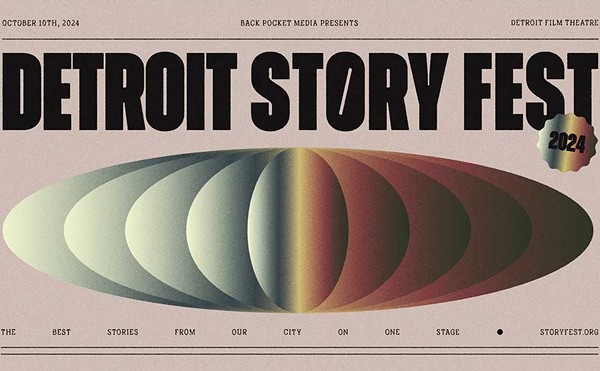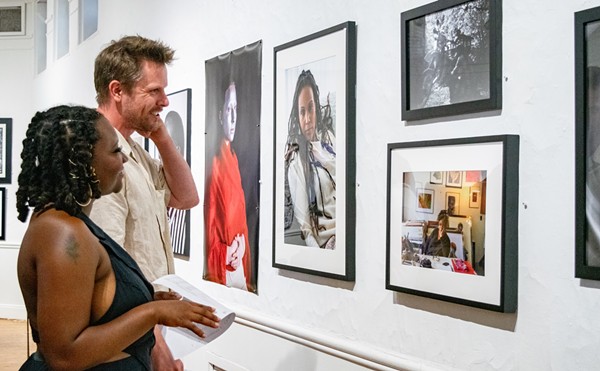As each new shipment of daylight spreads over the 75-year-old homes and businesses of Hamtramck, people with roots in 30 different cultures and languages begin stirring. In the '50s, this town within a city was a predominantly Polish and Ukrainian enclave; cultural "others" weren't entirely welcome; and if you didn't go to church on Sunday, somebody's grandma would notice.
But stats alone can't tell the story of Hamtramck's emergence as a multiculture, that oh-so-rare phenomenon at the end of this bloody, intolerant century. In the '60s, immigrants from Albania, Macedonia, Serbia, Yemen, and elsewhere, started arriving, and by the '80s African Americans and Detroit artists were joining the mix. One of those urban pioneers was sculptor Gary Zych, whose work often projected a clearly political message.
In 1993, after 10 years of living and making art in this diverse community of about 17,000, Zych mounted a campaign for City Council and won on his first try. He even received the most votes of all candidates and started off his political career as council president. It was quite a surprise, but certainly not an unprecedented event on the world stage: After all, playwright Vaclav Havel was president of the Czech Republic and poet Ernesto Cardenal joined the Sandinista government in Nicaragua. But why would a sculptor, known for an intense commitment to his art, choose to enter the wrestling ring of politics?
"First of all, my art always had a political content to it. I was involved with using text before it was really fashionable. The texts that I incorporated in my work had a lot to do with commercial signage, depicting the nocturnal, neon landscape of metropolitan Detroit É signs like the Goodyear Tire on I-94, the Kowalski sign here in Hamtramck, the Canadian Club sign on the Detroit River," says Zych, sitting in his studio that until recently doubled as a campaign workshop. Around him are the literal signs of his November mayoral race, the "Switch to Zych" panels that he and his supporters constructed on a shoestring, and which helped propel him to victory -- by nine votes! -- over 18-year incumbent Robert Kozaren.
Shifting gears
The move into politics, in fact, seems quite natural for Zych who, in his creative work, "had always referenced political situations like the Iran-Contra hearings, with pieces like Alibi Lullaby É from constantly hearing, over and over, excuses, the lulling of that spin on the political situation. É So my work was born in that arena and when it came to living in an artist-oriented community, I found that I couldn't ignore the politics around me."
Early on, the painful contradictions of the urban renewal process were what captured his attention: "At first, my interest was more from a preservationist standpoint. É Hamtramck was losing a lot of the landmarks that I feel identify the city. We lost the Martha Washington Theatre to a Wendy's; we lost the Palladium bowling alley, where there were state tournaments, to a Rally's hamburger stand; and we lost a three-story, terra-cotta structure at the corner of Holbrook and Joseph Campau that had a lot of potential, which today would be just a gold mine and a wonderful mall, a studio-store space, but we lost that to an Arbor Drugs. So that really became a point where I was questioning the direction of the city and I felt compelled to run for office."
Since being elected mayor in November, Zych has had heated clashes with the City Council, and last month the Wayne County Election Commission rejected proposed recall petitions, saying they can't be filed until the mayor's had six months in office.
'Artist's perspective'
As an artist-mayor who continues to teach design courses at Lawrence Technological University, what original thinking about Hamtramck does Zych offer? "I think I bring two things to the table from an artist's perspective. One, in terms of enlisting the support of community artists É to build a bridge between the stereotypical role of an artist as an isolated outsider and bring more of a voice to artists as a real part of the fabric of society. And number two, my efforts to move in the direction of preservation and maintaining the uniqueness of the city of Hamtramck, with a sensitivity to city planning, individuals, community organizations -- sort of the emphasis that I think Hamtramck always has had, as a place where people come to find an identity and make a home. É Artists particularly appreciate the sense of belonging and pick up on a sense of history in Hamtramck."
Does Zych have any specific projects for the city that involve an artistic outlook or consciousness? "I'm appointing a cultural commission which will identify the role of the artist in the community and create more of an exchange between the artists and the schools. There's a cultural plan that is often used in other communities as an economic development tool. I see that taking place very strongly here. And a beautification committee as well. My primary initiatives are to restore safety and sanitation to the levels that people remember in the city of Hamtramck. And that's a challenge."
Zych's agenda for his first two-year term of office -- he intends to be around for the long haul -- includes a zero-tolerance attitude to small crime: the passage of ordinances to stop public drinking and rowdiness, underage smoking and drinking, and urinating in the streets and alleys. Clubs such as the Motor Lounge, Lili's 21 and Paycheck's, Zych says, are attracting crowds of visitors and he wants to make Hamtramck streets thoroughly safe at all times. His motto for the developing nightlife scene is "Limos instead of winos!"
Zych says that his newly appointed director of public safety, John Watson, has pumped up the pressure on known drug houses, with serious busts and prosecutions already under way, vastly improving what had been a police see-no-evil policy in the past. According to Zych, his Department of Public Works Superintendent Andre Pietrucha recently suspended city workers for drinking on the job and operating machinery under the influence. He also discovered a stash of city equipment that workers claimed was lost or did not exist -- and a secret apartment(!) in the basement of City Hall, complete with phone, TV and other amenities.
Perhaps Zych's most courageous gesture, however, is his twofold cancellation of some police overtime and elimination of the notorious speed traps on the outskirts of Hamtramck that so alienated potential visitors. For years, according to Zych, officers had accumulated upwards of $50,000 each in overtime (on top of average salaries of $45,000) by running the traps up to 80 hours per week, sleeping in their patrol cars and putting some $90,000 a year in traffic fines into Hamtramck coffers. But the math for just one officer's salary and overtime wasn't working out in the city's favor (especially with more than one officer involved). Meanwhile metro Detroiters often felt like they were being harassed on their way to shopping or club-hopping in Hamtown. Not great public relations, to say the least.
What are the resources that Zych feels he can draw on in what essentially looks to be an uphill battle?
"What's very satisfying is the fact that this is a blue-collar town and people here appreciate hard work. And artists aren't any different from other people; they work hard 'cause they're on their own. People in this community, the longtime residents, have a genuine interest in people, in their neighbors, and they look after their neighbors and are interested in what they do. In the new urban design plans, the ratio of the distance from your porch to the street and from porch to porch -- what we have in Hamtramck -- is somewhat of an ideal model that strengthens a sense of community, the row-house style. If you look at Royal Oak on Main Street, the new condominium developments have front porches with close access to the street and they're near walking distance to the downtown. We've had that built into our city since day one. And it works."
Gary Zych's latest project, his full-time job as visionary artist-teacher-mayor of Hamtramck, seems to have become the artwork of a lifetime.
George Tysh is Metro Times' arts editor. E-mail him at [email protected]




